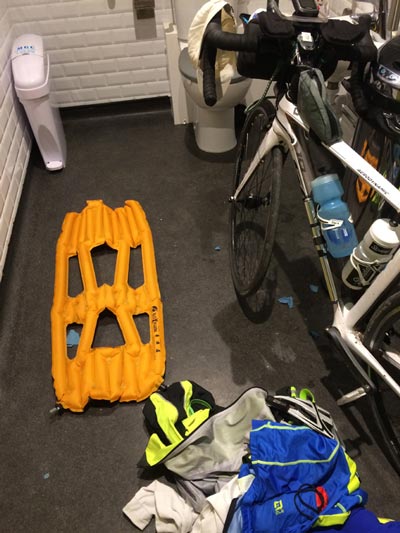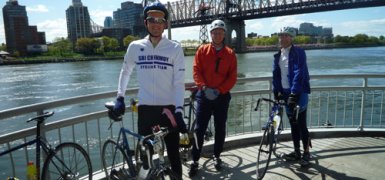As a lifelong cyclist, for the past few years I have sought out longer and longer rides as a way to challenge myself, but as a relative newbie to endurance cycling, I cannot claim to be an expert or an authority on the subject. I still get things wrong when I undertake new projects, but in sharing my adventures with a wider audience, I hope to inspire people to have a go at new things without being afraid of the outcome. Although planning is important in these endeavours, too much procrastination can lead to something never getting done, so I would encourage people to set out and start something small to begin with, and maybe just a little outside of their comfort zone, but to start!
At the time of writing, I am preparing for the Indian Pacific Wheel Race, which is a 5,500km unsupported bicycle race across Australia. It starts in just over 2 months time and my mood is alternating between euphoria thinking, ‘this crazy scheme might just work’ and despondency, ‘there’s no way I can last even a day let alone 3 weeks’.
I have been wary of writing about preparing for such events, not because I am afraid of giving away information, but because I find that too much focus on the external things can indicate a lack of inner focus. Hence, in my ramblings, I will try and balance the two, both inner and outer, so that I do not forget what is important and what it really is that gets one through these rides. Certainly a working bike that is comfortable is a prerequisite, but it does not have to be the latest and greatest model because it still needs to be ridden when one is tired and sore.
 There are quite a few race reports available to read on line and in journals about long distance events, and yet, I would like to start writing about mine now because I do not feel that the race will start on March 17th and finish sometime later. For me, it has started already. Maybe it started when I was a child and first learned to ride, but there has been a progression and continuation in my life that, stepping back, finds it hard to draw a line between ‘this’ and ‘that’. There seems to be a flow where everything that happens has the ability to teach us something and enrich our progress.
There are quite a few race reports available to read on line and in journals about long distance events, and yet, I would like to start writing about mine now because I do not feel that the race will start on March 17th and finish sometime later. For me, it has started already. Maybe it started when I was a child and first learned to ride, but there has been a progression and continuation in my life that, stepping back, finds it hard to draw a line between ‘this’ and ‘that’. There seems to be a flow where everything that happens has the ability to teach us something and enrich our progress.
This thought occurred to me quite clearly when I was recovering from a big ride last year. There was a set distance, a start time and a time limit which I had to finish within for the ride to ‘count’. Yet, in the days, weeks and months that followed, as my body started to slowly heal, I felt that this recovery period was also part of the event. It was a direct consequence of what I had put myself through and it needed to be honoured and respected as much as the ride itself.
For such a simple task – just riding one’s bike, there seems so much to plan for and try to anticipate. For the Indy Pac Race for example, I have been looking into sleeping systems. On my longest ride to date, a 5 1/2 day, 1650 km ride through England, Wales and Scotland, I made some basic mistakes with regard to sleeping arrangements. The nights in May/June were still cold and I did not carry enough warm gear to sleep out at night. This is because my luggage carrying capacity was insufficient and I thought I could survive by just wearing my cycling clothes, using a minimal mattress and a bivvy bag. It did not take long for me to realize that this set up was woefully inadequate.
During the first night I lay awake shivering for 2 hours in a deserted church porch instead of sleeping. My only option was to get up, pack up and continue riding through the night in order to warm up. This set the tone for the rest of the ride as I looked for hotels each night. This process wasted precious riding time and caused a degree of anxiety which I am keen to avoid in Australia. For these reasons, I will increase my luggage carrying capacity and take a warm sleeping bag, as I believe the nights might get down to zero degrees centigrade in the desert and in the Southern Alps. In other places, it might not be that cold, and so I will use just the bivvy bag, but at least I will have some options.
Scouring the internet seems par for the course when undertaking these adventures. Whether it is shopping for gear, reading reviews of equipment or trawling endlessly through Google street view to find out what a route Is like and where there might be shelter.
Looking into sleeping bags in particular, has caused me to rack up a lot of internet time. I have discovered that there are sleeping bags, and…. sleeping bags. My requirements for the event are to have a bag that packs down really small and is lightweight. Oh, and it needs to keep me warm at freezing point too. I have discovered that it is possible to tick all these three boxes, at a price. Initially I baulked at spending more than half my airfare to Australia on a bag, but after ordering one that was warm and light-ish but had a huge pack size, I realized that I had to commit more fully to the project and splash some cash on a specialist item. The kind of bag I ended up ordering is the type used for desert races like the Marathon Des Sables. If I can use it enough during the Australian race, it should offset the cost of Hotel alternatives, be quicker to set up at night and leave in the morning. Admittedly it will not afford me the luxury of clean towels and bed sheets, but it should save me from being cold and from the anxiety of trying to find hotel vacancies late at night en route.
To be continued…

